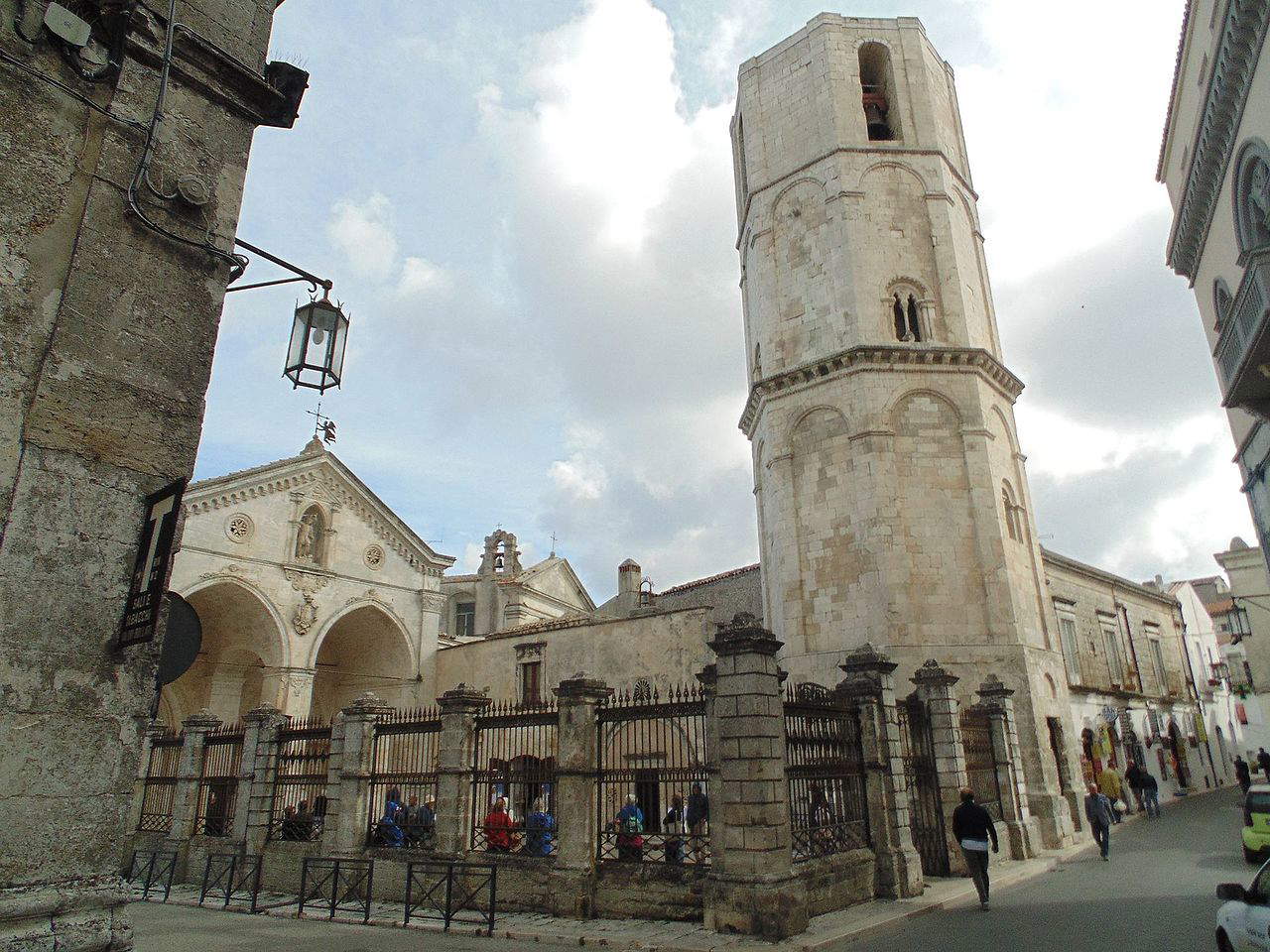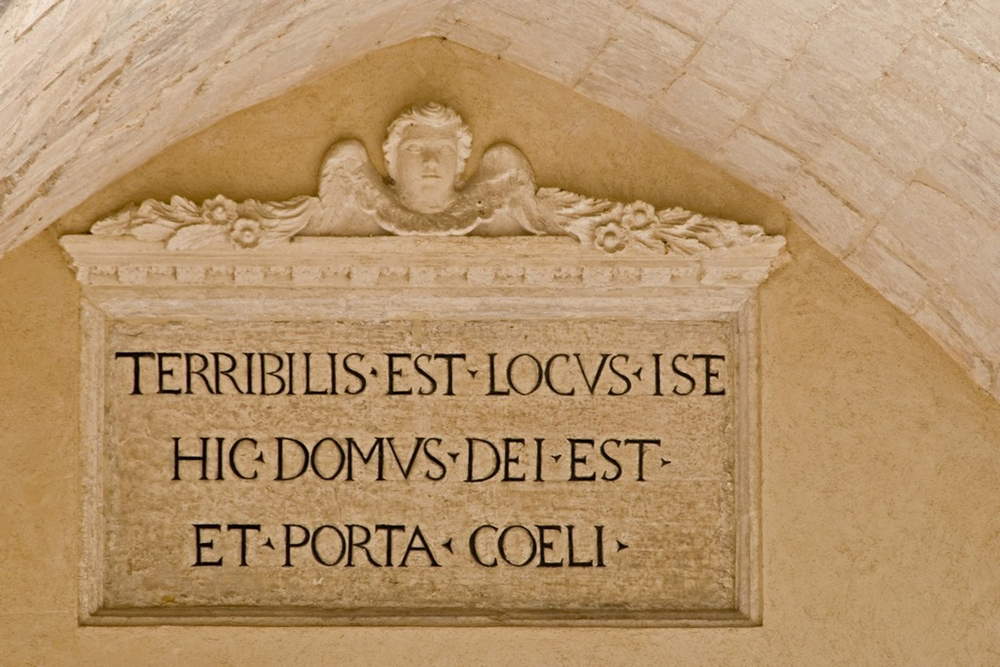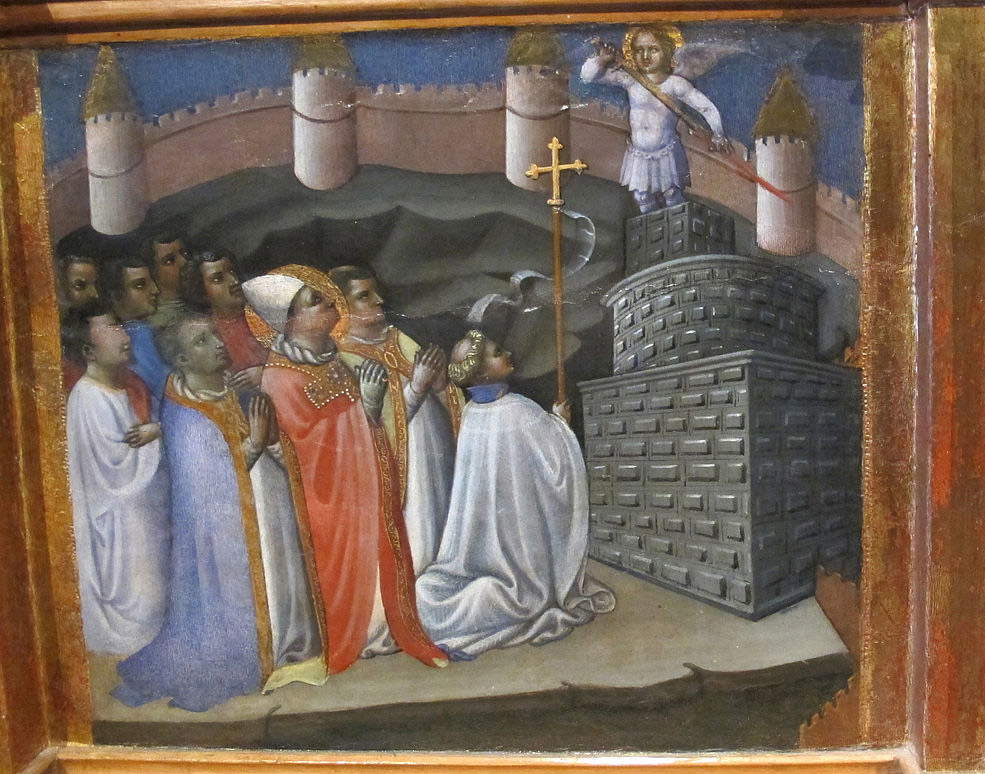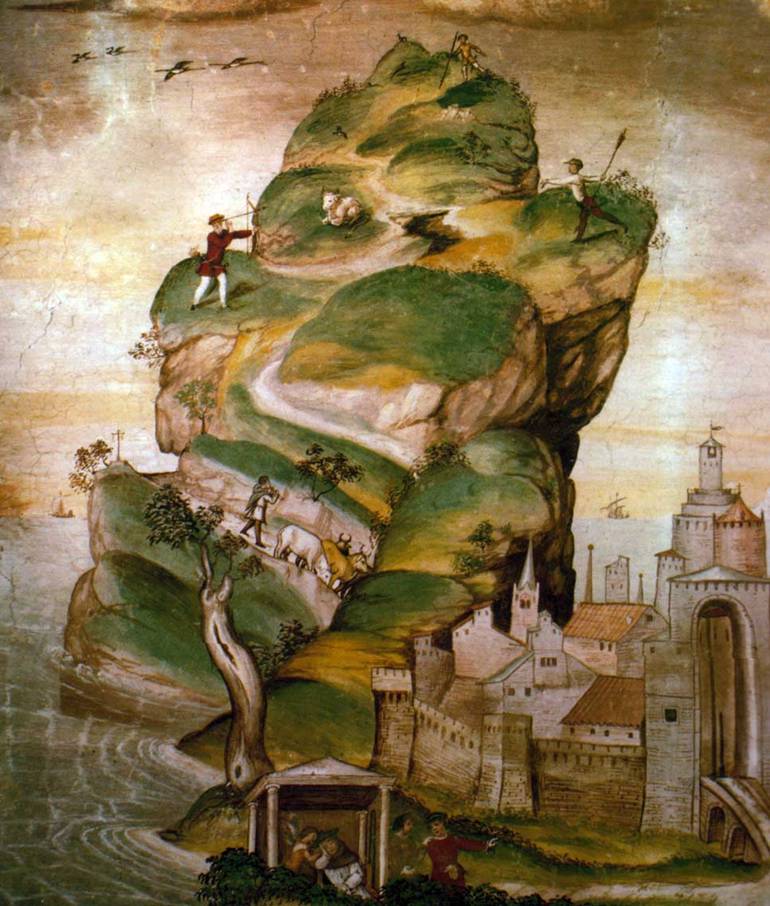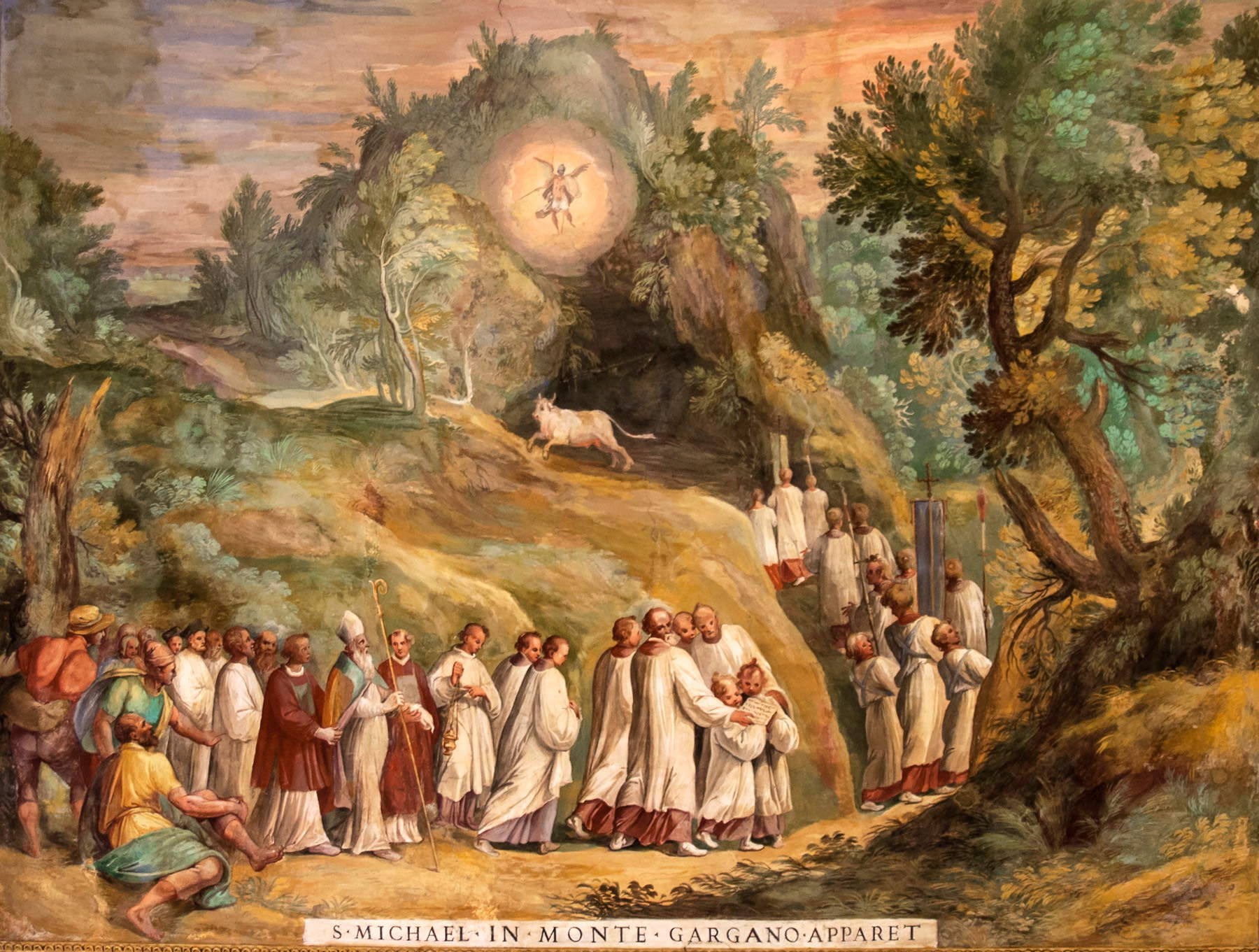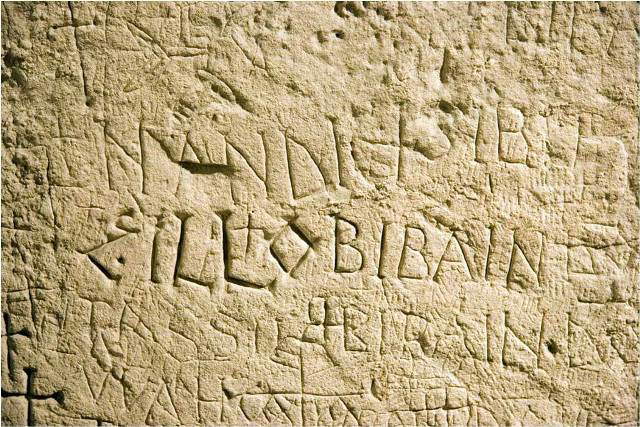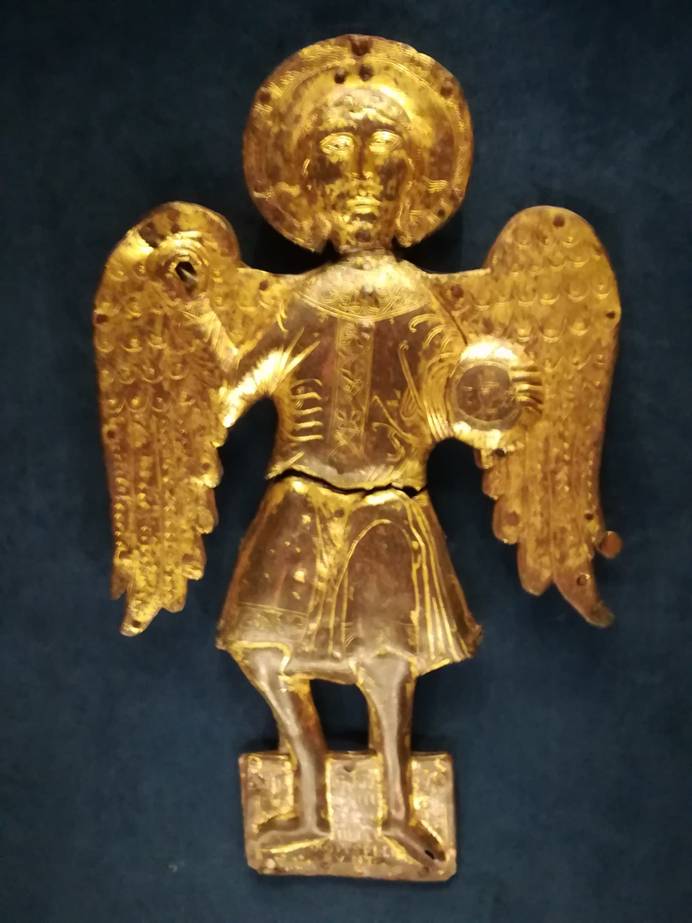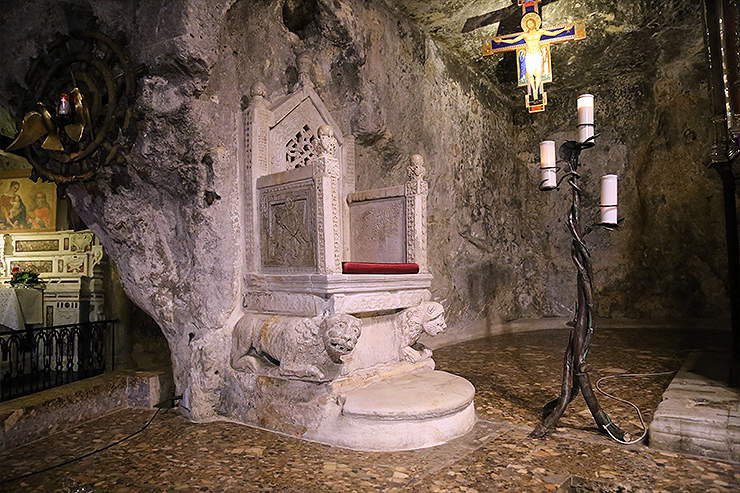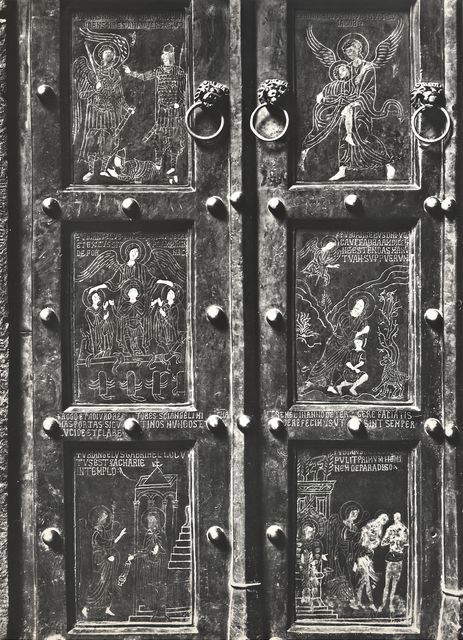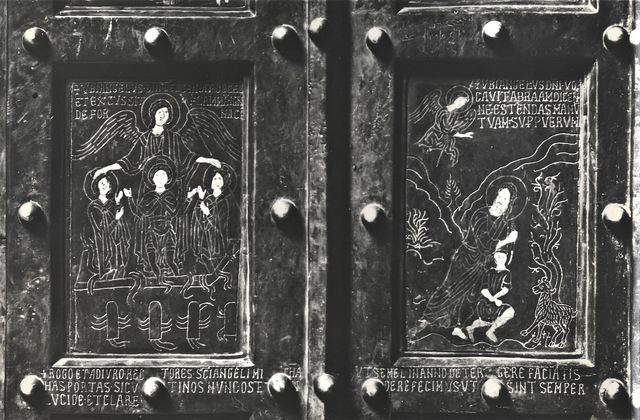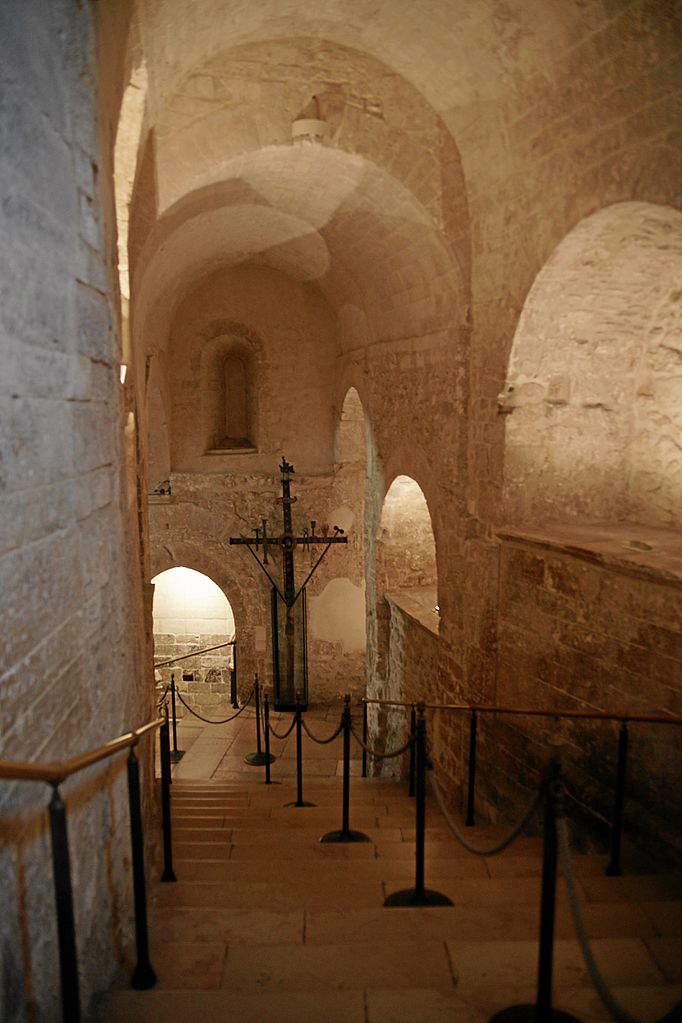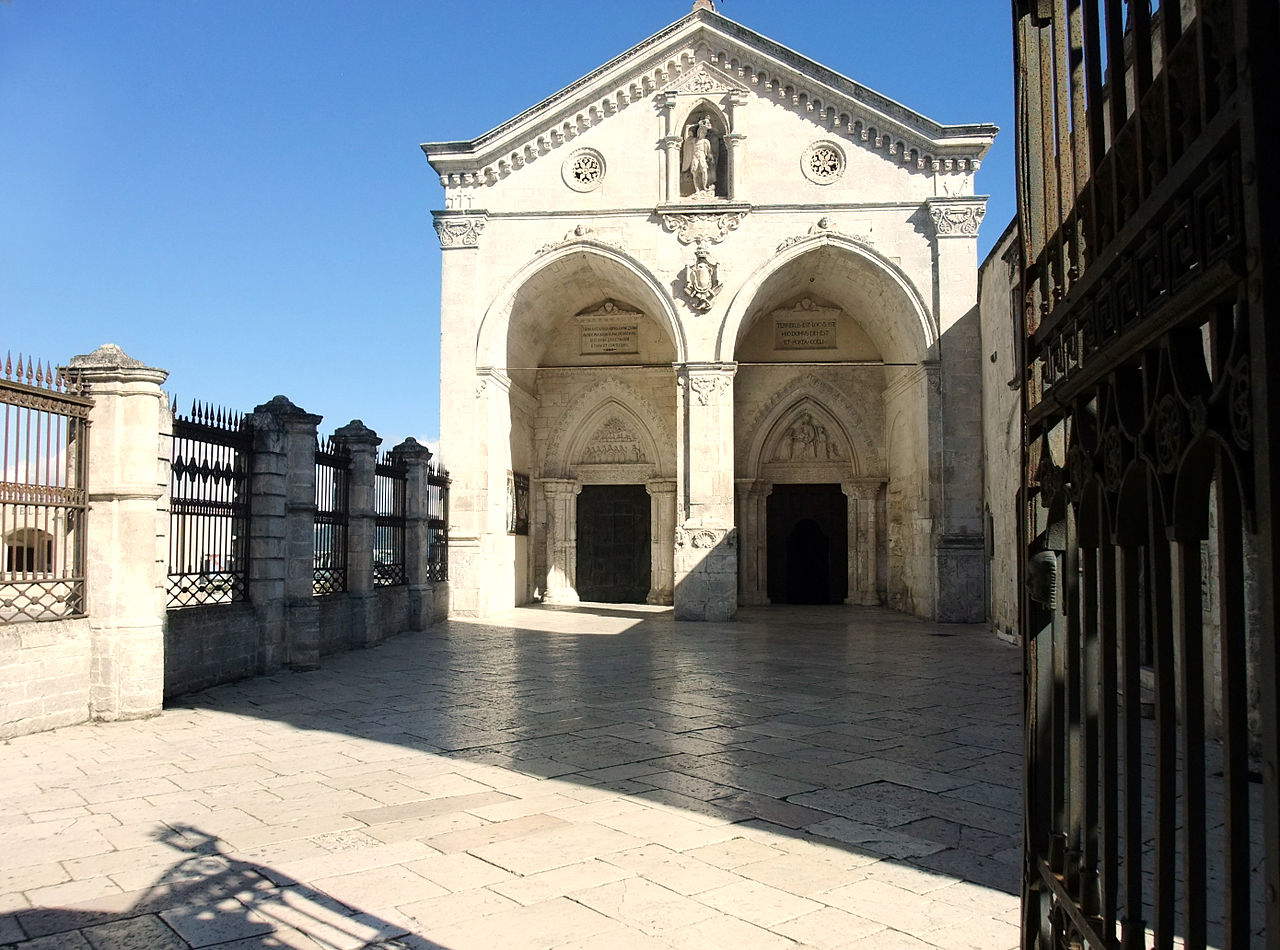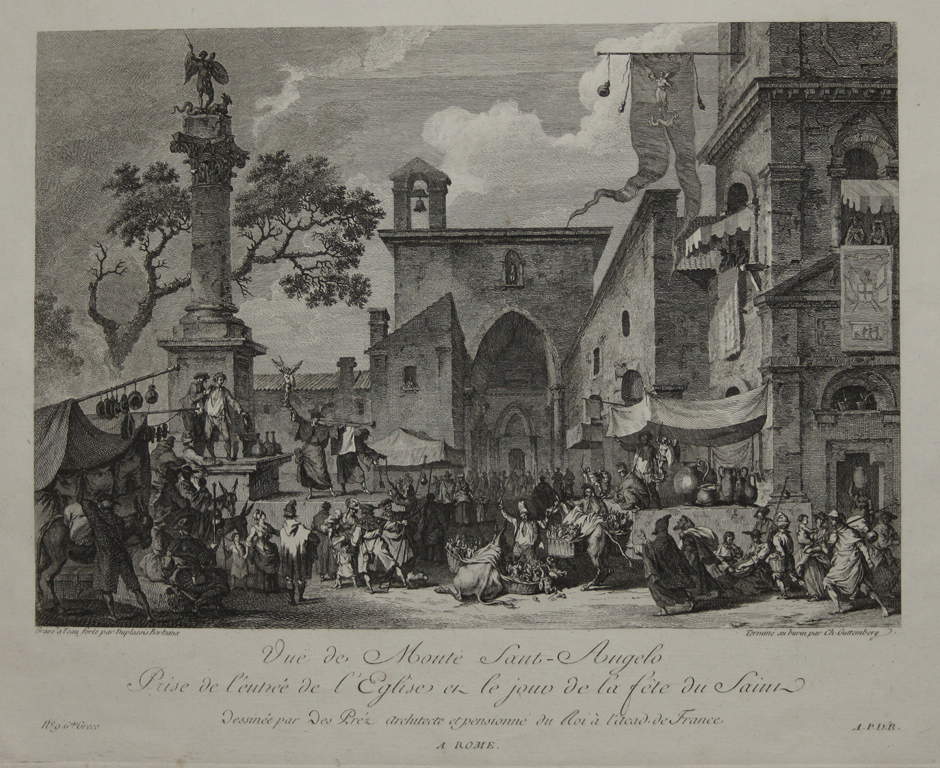by Romeo Pio Cristofori , published on 30/06/2019
Categories: Works and artists
/ Disclaimer
The Sanctuary of St. Michael in Monte Sant'Angelo on the Gargano promontory is a place where art and devotion come together. Here are the origins of the shrine dedicated to the Micaelic cult.
“Terribilis est locus iste.” The entrance to the “heavenly” basilica of St. Michael the Archangel at Monte Sant’Angelo on the Gargano promontory is topped with an inscription that sums up the enormous value, not exclusively spiritual, of the ancient shrine. “Terribilis est locus iste” meaning “this place arouses deference.” Like few other places in human history, the famous Gargano cavern is in fact characterized by continuous and constant use for liturgical purposes that has made it a place of extraordinary historical and cultural stratification. Excluding here the purely religious value that still permeates the place, that inscription (threatening only to an approximate translation) warns how the Gargano sanctuary is a place that arouses attention and regard, a regard not only devotional but also civic and historical. In fact, to move through the spaces of the centuries-old place of worship and descend into the sacred grotto, according to tradition consecrated directly by the archangel, is to immerse oneself in a space where history is grafted into faith and beliefs and then manifested in the most innumerable forms.
Indeed, it is impossible to study this unusual shrine without beginning to untangle the long thread of events and historical-artistic evidence by starting precisely from its complex origins somewhere between history and legend. If in fact we can affirm that historically the micaelic cult had to land on the Apulian promontory from the East, and in particular from Constantinople where it was already widely spread in the 4th century, from the point of view of tradition the beginning of angelic veneration is to be placed between 490 and 493 when the heavenly soldier appeared three times.
The history of the shrine and the reconstruction of the cult are based mainly on the Liber de apparitione sancti Michaelis in monte Gargano (also known as Apparitio), a unique anonymous text composed probably around the 8th century. The fundamental manuscript, also used in part as a source by Jacopo da Varazze in the writing of the later Legenda Aurea, divides the tale into three parts by starting the narrative from the famous episode of the bull in which a wealthy shepherd, eponymous with the Apulian promontory, returned to the fold with his sheep and realized that his best bull had escaped again. Thanks to lengthy searches, Gargano found his animal inside a cave and, exasperated by the fatigue and yet another escape of the bovine, decided to shoot a poisoned arrow, which, miraculously returning, struck the shepherd himself, however. Intimidated by the incident, the inhabitants of the town of Siponto, in whose territory the cave lay, turned to a bishop (only later identified as Lorenzo Maiorano) who ordered a three-day fast at the end of which the archangel Michael miraculously appeared to the same bishop. The angelic soldier informed the prelate how the event had been engineered by him to show the population and the bishop himself how he was the “patron and guardian” of that cave and of the entire mountain. The first micaelic apparition, depicted numerous times in the history of art (from Priamo della Quercia to Lucano da Imola, from Antoniazzo Romano to Cesare Nebbia), thus concludes the first episode and quickly gives way to the second part of the tale in which the Neapolitans (Byzantines) waged war against the Sipontines and Beneventans (Lombards). The archangel appearing again to the same bishop of the first tale, who had invoked him together with the local population during a brief truce granted by the Neapolitans, announced the Lombard victory in the battle the next day thanks to his prodigious intervention. The aforementioned victory, which took place according to theApparitio in 492, also ends the second part to give way to the concluding episode of the “Dedication” in which the usual bishop, up to that time quite afraid to enter the cave to venerate the heavenly saint at the site of the first apparition, decided to consecrate the cave in the year following the great victory. Arriving at the entrance to the cavern, however, the archangel appeared a third time to announce how it was not a human task to consecrate the basilica directly built by the divine emissary: “I who founded it, I myself consecrated it. But you also enter and frequent this place, placed under my protection.” It was September 29 in the year 493, the day on which we still celebrate St. Michael the Archangel, and the holy place being the only temple in Christendom not consecrated by human hands, it received the title “Celestial Basilica” over the centuries.
 |
| The Sanctuary of St. Michael in Monte Sant’Angelo. Ph. Credit Ito Ogami |
 |
| The Shrine of St. Michael in Monte Sant’Angelo. Ph. Credit Sanctuary San Michele |
 |
| The inscription “Terribilis locus est iste” at the entrance to the shrine |
 |
| Priamo della Quercia, Apparition of Saint Michael on the Gargano (predella of the Brancoli triptych-tabernacle, c. 1430; tempera on panel; Lucca, Museo Nazionale di Villa Guinigi). Ph. Credit Francesco Bini |
 |
| Lucano da Imola, Mount Gargano and the City of Siponto (1550; Bergamo, San Michele al Pozzo Bianco) |
 |
| Cesare Nebbia, Saint Michael Appears on Mount Gargano (c. 1592; fresco; Vatican City, Vatican Museums, Gallery of Maps) |
If the first and third episodes have been interpreted as the ancient nucleus of an original local founding legend, born shortly after the beginning of the angelic cult and referable to the first centuries of the sanctuary (5th - early 6th century) the second episode is in all probability the result of a later interpolation (6th - 7th century) made in order to link the cult, until then under Byzantine influence, to Lombard domination. It is in fact no coincidence that the temple, suitably renovated, soon became a national shrine of the Lombards, the archangel Michael their protector and the episcopal see of Siponto incorporated into that of Benevento, thus transforming the cult into a very powerful instrumentum regni.
And it is precisely in this early historical phase of the sanctuary that the greatest difficulties in a philological reconstruction of the complex and its subsequent numerous alterations and transformations also lie. Providing us with the earliest description is once again theApparitio, which informs us how in the early centuries the cave was originally divided into two: a smaller and lower one in which the archangel had left his own footprints (hence the altar of footprints) and a larger one in which, again according to tradition, over a different altar the saint would lay his cloak and a small jar containing miraculous water. These two caves were accessed through a narrow cleft in the rock around which a first church, the Byzantine one, was built, the few surviving parts of which were identified only in the last decades of last century thanks to major archaeological campaigns. The Byzantine building, to which they later put a long portico, must have basically consisted of a large room, a kind of gallery, which through some complex stairs literally came out into the first crypt, the crypt of the footprints, through which one then entered the actual cave of larger dimensions.
From the middle of the 7th until the 8th century, the Micaelic shrine underwent numerous renovations and expansions, financed by the Lombard dukes and desired in order to enlarge the spaces for easier use by the ever-growing faithful. The first interventions desired by Romuald I (662 - 687) led to the construction of a new staircase, which, however, soon became obsolete. In fact, after the demolition of the rocky septum that divided the two cavities and the consequent creation of a single large room, it was decided to build a new monumental access which, joining a complex vaulted structure, was configured as a long gallery corresponding to the present Lapidary Museum of the basilica. The rediscovery of this area, which took place thanks to lengthy archaeological excavations, has allowed its complete musealization but above all the identification on the pillars of the great staircase of numerous pilgrim inscriptions, extraordinary testimonies to the success of the Micaelic cult. Precisely the numerous epigraphs are incontrovertible proof of the sanctuary’s centrality (not only cultic but also political and strategic) in the early Middle Ages. An importance that the miraculous cave did not lose even after the unraveling of the Lombard principalities or in the following centuries as evidenced by the numerous Saracen attacks between the late ninth and early tenth centuries, the strongest of which (in 869) had to severely damage the complex. It was perhaps because of this damage that Emperor Ludwig II (825 - 875) decided to grant Aione, the archbishop of Benevento on whom the shrine depended, the means to restore the church.
 |
| Pilgrims’ inscriptions. Ph. Credit Longobards in Italy |
 |
| The Lapidary Museum |
Although it is impossible to know the extent of the Campania prelate’s restoration work, critics agree in approximating to that important commission the few surviving fragments of the fresco decoration of masonry, sub-arches and pillars that anciently must have covered the spaces in front of the sacred cave. A decorative campaign that had to be repeatedly resumed and transformed over the following centuries, surviving the domains that adapted it to their most diverse needs. The surviving frescoes, most of which were detached in the 1960s, represent mainly plant or floral decorative elements, small pieces of faux-marble mirroring or subjects with symbolic meanings such as the so-called Custos Ecclesiae. Found between 1949 and 1955, detached in 1965 and now on display of the sanctuary’s Conference Hall, the Custos Ecclesiae depicts a bareheaded monk with short, tonsured hair, large eyes and a white robe. With his right hand the young priestly figure holds what appears to be a small cup while his face is in the center of a square nimbus attribute then reserved only for the living. Its proximity to the ancient access to the cave of footprints, the discovery in the plaster of two silver denarii of Otto II (962-973) and the interpretation of thepartially surviving inscription surrounding it, have allowed it to be identified with a Leo “episcope and sinner,” perhaps the archbishop of Siponto who gained independence from Benevento in 1034 or perhaps Pope Leo IX (1049 - 1054) an assiduous visitor to the shrine. Whatever its identification, the detached fresco is one of the best pictorial testimonies that can be placed between the mid-9th century and the first decades of the 11th century, as well as one of the very first historical-artistic testimonies of the sanctuary. A place of worship that in those same centuries had to be the center of attraction of a particularly refined and extraordinarily fine artistic making, as demonstrated by the beautiful Archangel Michael in gilded copper in the Monte Sant’Angelo Devotional Museum. Through an embossing of a thin sheet of gilded copper the figure of the archangel is revealed to our eyes according to an iconography fundamentally new for the 11th century. The celestial soldier is in fact depicted not in the usual imperial or military garb but in an elegant short tunic typical in depictions of some figures belonging to the Lombard royal lineage. The original robe, interrupted today by the later break that separates the bust from the legs, has elegant decorative motifs etched very lightly on the surface to feign embroidery on the shoulders, bust and hem. The rounded face, perhaps worked separately and then rejoined to the body, is surrounded by curly wavy hair and a finely decorated halo, while the wings unfold to accommodate the two hands, one of which, the right, must formerly have housed a downward-facing spear as evidenced by the small surviving fragment still visible between the fingers. A very fine object, in all likelihood a precious votive gift to the saint, as suggested by the dedicatory inscription on the suppedaneo in which Robert and Balduino style=“font-weight: normal;”>, perhaps two pilgrims of Frankish origin, are remembered. The extraordinary artifact, the result of a fortuitous discovery in a recess of the cave in 1900 and datable within the first half of the 11th century, is together with the Custos Ecclesiae fresco among the few historical and artistic testimonies of the early Middle Ages that ended in the Gargano basilica with the return of Byzantine rule.
The re-established power operated a real “rebizantinization” of the Micaelic cult carried out through the hagiographic campaign in favor of Bishop Lorenzo Maiorano, a relative of Emperor Zeno and anciently sent to manage the Sipontine church. Lorenzo, appropriately identified with the bishop mentioned in the earlier apparition account, was extensively reused by that Leo first independent Sipontine bishop, perhaps identifiable in the aforementioned Custos Ecclesiae. It is precisely to the figure of Bishop Leo and his activity as a patron that the numerous surviving signs of this period of great fervor for the shrine are to be traced, among which the extraordinary ambo lectern now in the Museo Lapidario stands out. The work, dated and signed by the sculptor Acceptus in 1041, is probably a commission from Leo, who in those very years had entrusted the same sculptor and his collaborators with a similar specimen for the church of Santa Maria di Siponto. The precise choice of the Sipontine bishop, namely, to approximate the liturgical furnishings of the heavenly basilica to those of his episcopal see, denotes the centrality of the artistic medium in affirming equal dignity among ecclesiastical buildings as well as, simultaneously, an emphasis on the direct dependence of the cave church on episcopal power. A Byzantine world easily identifiable even in the stylistic doing of the sculptor, who seems to look to the tradition of Ebonnean artifacts from which he draws inspiration not only for the iconographic aspect but also for their technical realization. Yet Acceptus proves to be an exceptional sculptor capable of rereading tradition by providing a new reading of it with extraordinary expressive power. The recent reconstruction, presented on the occasion of the beautiful rearrangement of the Lapidary Museum, helps to understand even more the extraordinary value of this piece that was part of an ambo destroyed in an unspecified period. The work was in fact centrally inserted in a structure with a rectangular base supported by four columns with as many capitals and bordered by four marble slabs (unfortunately lost) resting on carved beams. Above, before the eyes of the faithful, the tall eagle holds an open book with the function of a lectern while displaying all its extraordinary stylistic refinement through the tasteful expedient of the two half-open wings. A work that is thus placed not far from the end of the so-called Greek rule and the intervention of the Normans who only a few years later would establish themselves in Apulia as lords and masters. With the new domination those early claims to bishop’s rights already demonstrated by Leo with the commission ad Acceptus reappeared with even greater force as shown by the juxtaposition of the Sipontine prelate with another extraordinary work: the bishop ’s throne of the cave church. Placed still today inside the apse of the sanctuary, the extraordinary pastoral seat was approached, however, only much later to Leo as a careful analysis of the inscription on the frame of the back shows. The engraving was probably made around 1127, when Pope Alexander III promulgated a bull in favor of the basilica’s concattredality, which was later revoked as early as a few years later. This opens up a complex chronological situation exemplifying the complexity of studies related to the artifacts and the history of the shrine. In fact, the later inscription does not rule out the possibility that the work is in fact older and that at the time of the issuance of the papal bull only the engraving had been made in order to leave a memory of the event on the very object that best represents episcopal power. On the other hand, the two lions supporting the simple marble structure on its back could even be the result of a later (perhaps thirteenth-century?) artistic culture. Moreover, it is important to remember how the beautiful, finely crafted object is not monolithic but the result of the composition of several marble elements, which could have been easily replaced when moved or damaged. The throne of Monte Sant’Angelo thus encapsulates that uncertainty that still hovers over the period between Byzantine rule and the sanctuary’s new Norman power and that also marked the entire complex very deeply. Almost certainly under the reign of Robert Guiscard (1015 - 1085) the basilica underwent major transformations of which, however, only the entrance portal to the church and the misunderstood yet extraordinary bronze doors of Constantinopolitan import donated by the Amalfi nobleman Pantaleon in 1076 survive.
It is precisely around the bronze doors, which still demarcate access to the basilica, that one of the most interesting critical proposals about the major transformation of access to the sacred space settles. In all likelihood, in fact, the two doors, formed by a heavy wooden frame covered with oricalco (an alloy of copper, zinc, lead and little silver) tiles and fixed by strong frames of the same metal stopped by studs, closed from the very beginning of their installation the’access to the church to pilgrims who no longer entered from below through the primitive structure, but descended from above, that is, from the urban agglomeration of Monte Sant’Angelo that was beginning to expand in those years. Proof of this is the total absence in the entrance hall of any structural and decorative elements referable to the Angevin or Gothic period, which instead should have been present if the access from upstream had been realized only in the Angevin period. In all probability, therefore, already in the second half of the 11th century a long flight of steps carved into the rock must have been present, which was later enlarged and greatly modified at the time of Charles I of Anjou. The bronze portal with the 12 panels depicting apparitions of the archangels Michael and Gabriel linked to local, Roman and Cassinese traditions quickly leads us out of Norman rule leaving room for the Swabian presence unfortunately very little documented in relation to the sanctuary. The one precious exception is the stupendous rock crystal and filigree cross traditionally believed to be a personal gift of Frederick II and now preserved in the Chapel of Relics. Indeed, the emperor, who also did not initially disdain the pillage of the basilica, donated a fragment of the real cross embedded in this splendid object on his return from the crusade in 1228. Possibly of Venetian or French manufacture, the stauroteca can be dated to around the 12th century albeit involved in countless restorations and interpolations by very skilled southern silversmiths, who finally fitted it with an embossed and cast silver foot. A precious object that had to give new life to that extraordinary collection of priceless works of goldsmithing and silverware that constituted the ancient Treasury of the sanctuary preserved in spaces that, unlike the precious collection, were not to enjoy special attention during the Swabian domination.
 |
| Unknown artist, Custos Ecclesiae (mid-9th to early 11th century; detached fresco; Monte Sant’Angelo, Sanctuary of St. Michael) |
 |
| Unknown goldsmith, St. Michael (11th century; gilded copper; Monte Sant’Angelo, Devotional Museum) |
 |
| Acceptus, lectern of ambo (1041; marble; Monte Sant’Angelo, Museo Lapidario) |
 |
| Monte Sant’Angelo, Sanctuary of St. Michael, the cave church |
 |
| The bishop’s throne in the cave church |
 |
| Unknown Byzantine artist, Bronze door of the sanctuary of St. Michael (11th century; bronze; Monte Sant’Angelo, Sanctuary of St. Michael) |
 |
| Unknown Byzantine artist, Bronze door of the sanctuary of St. Michael, detail |
Instead, it will once again be the architecture and environments of the complex that will be the protagonists in the 12th century when the sanctuary became the privileged object of the care and direct interventions of the first Angevin rulers. In fact, Charles I decided to intervene heavily by initiating a complex process of monumentalization of the spaces, which led to the redefinition of the path of descents into a wide, multi-flight staircase that would allow descent into the church from the upstream town center. The new access route also led to the redefinition of the entrances near the cave and the construction of a large proto-Gothic nave, relegating the previous Lombard and Byzantine structures to the underground. The cave rooms were also subjected to a major overhaul, probably involving the entire church furnishings and the dismantling of the Acceptus ambo in part later reused in the new altar. The new entrance near the town finally entailed a final intervention that led to the creation of the small square in front of the entrance (c. 1271), the building of the octagonal bell tower by protomagisterGiordano and his brother Marando (begun in 1274), and the drafting of a major plan for the transformation of the town to better accommodate pilgrims. The sanctuary of St. Michael was by then very close to what we can still visit today, but missing from the roll call were numerous decorations and depictions that from this time transformed over the centuries, overlapping or replacing one another, the form and meaning of the sacred space. Transformations and renovations that never lost, however, their close relationship with royal power and the various ruling houses. Evidence of this is the remarkable entrance portal, now the one on the right after the 19th-century doubling of the facade, where in 1395 perhaps on the commission of the Angevin princess Margaret, mother of Ladislaus, a carved lunette was placed with the Virgin Mary and the divine infant, between Saints Peter and Paul and the commissioner herself. In spite of a certain formal harshness, the work marks the definitive landing in the Gothic of the local artistic language by an artificer such as Simeon, who signed the work in the lintel, but above all it underscores the symbolic value of that access. In fact, the unusual presence of Saints Peter and Paul, figures par excellence placed at the entrance to the heavenly realm, is perfectly connectable to that warning from Michael mentioned in the opening about the reverence that the shrine was meant to inspire. A reverence and devotion that led royal patrons to send on site or ship to the Gargano grotto works that were the fruit of artists with not only local but more generically European culture, as, moreover, was the Angevin court itself. The Holy Trinity found in 1922 walled up in the niche that still houses it, exactly behind the statue of the Redeemer now in the Museo Lapidario, denounces in fact a formal approach of the Provençal or more generically French area. A very interesting work, therefore, that underlines once again the great historical richness inherent in the sanctuary, protagonist like few other places of worship of an uncommon cultic continuity. And so the depiction of the Trinity, interpreted as a single figure wrapped in a wide robe from which emerge two hands but three scarred heads, tells us how the Gothic-age work (late 14th - 15th century) had to suffer the post-Council violence (1563) that first irretrievably destroyed the three faces and later (around 1628) led to the complete walling of the niche. Similarly, the Redeemer, then placed to cover the walled niche, was also moved several times and used as a simple devotional sculpture, erasing its Catalan origin that can be found today thanks to an analysis of the forms and proper museum use.
At the beginning of the 15th century, therefore, the shrine was a place already charged with a complex centuries-long history, as well as a place of pilgrimage under the direct dependencies of the sovereigns who enriched it with works of art and substantial economic handouts. Yet it was still far removed from its present situation. Located on the edge of the town, not far from the Frederician fortification, ancient descriptions outline it as bordering on the wild, surrounded by commercial activities of all kinds and genres and an oppressive mass of poor people waiting for alms. A fine print from theAbbot of Saint-Non ’s Voyage pittoresque of about 1781-86, though characterized with that sense of the grotesque typical of eighteenth-century prints, helps us to understand a situation very different from the present. The same print also allows us to understand the appearance of the sanctuary until 1865 when it was decided to provide the basilica with a more consonant facade that altered the original appearance and removed the famous column with the archangel that gave its name to the entrance hall, known as the "Atrium of the Column." A remake, the nineteenth-century one, that definitively negated, perhaps even more than the damage of time, the purely “modern” appearance of the sanctuary, erasing the last tangible historical-artistic remains, already, however, much damaged by historical events (one among them the devastating Napoleonic spoliation). Yet, though few, the valuable historical-artistic testimonies pertaining to the modern age powerfully mark the image of the church and the figure of St. Michael himself. It is precisely between the end of the fifteenth and the very first years of the sixteenth century, in fact, that the statue of St. Michael the Archangel that is still venerated in the Catholic world and a prototype in later centuries for the depiction of the saint arrived in the basilica. An extraordinary work that because of its profound religious value, as well as its miraculous aura, has for too long been overlooked by historical-scientific studies that have too often dismissed it as a mere devotional figure. The work replaced the last of three previous simulacra of the saint that followed one another starting in 1323, with the one commissioned by the Queen of Naples, Mary of Hungary, wife of Charles II of Anjou, until 1488 when Ferrante of Aragon cast to make coins the third silver reproduction donated by his father, Alfonso I of Aragon, only in 1447. The commissioning of the marble sculpture would thus be linked to the visit of Ferdinand the Catholic, on pilgrimage to the shrine in 1507, who allegedly had Consalvo di Cordova, Grand Captain of the Kingdom of Naples awarded the Honor Montis in 1497, commission a statue of the archangel worthy of the important pilgrimage site. The viceroy had to turn to a sculptor of Tuscan background who was particularly up-to-date on the Florentine artistic situation in particular, perhaps relying on the advice of the archbishop of Siponto, the Tuscan-born Cardinal Ciocchi del Monte, who perhaps steered the commission toward an artist of Sansovinian background such as Andrea di Pietro Ferrucci also known as Andrea da Fiesole (Fiesole, 1465 - Florence, 1526). In fact, the beautiful sculpture has a strong Donatellian ancestry in the compositional scheme of the archangel’s body, which, thanks to a clever chiasm structure, combines the bent arm behind the head with the classic outstretched leg and vice versa, with the outstretched arm softly holding the cloak, the bent leg crushing the deformed demon. All of this, coupled with the extraordinary workmanship of the cuirass, the shoehorns, and the very soft curls, combine to create a figure that never more than in this case is correct to call divinely angelic. A calm solemnity that would become a fixed iconographic element of future replicas of the fortunate subject, despite the fact that in 1610 the two original wings were removed in favor of two silver ones, which were chiseled at the expense of the Canons of the Sanctuary along with the Sword, which was also replaced with one in precious metals. The 16th-century image of St. Michael thus became in a few years the best-known depiction of the celestial saint, favored also by the replicas of the sculptors of Monte Sant’Angelo, the so-called sanmichelai, who already by royal privilege of the Aragonese sovereigns on Sept. 13, 1475, possessed the exclusive right to reproduce in statues and paintings the micaelic effigy throughout the kingdom of Naples (extraordinary are the testimonies of the Devotional Museum).
 |
| The Angevin staircase |
 |
| The octagonal bell tower. Ph. Credit Patrick Nouhailler |
 |
| The small square |
 |
| Master Simeon, Virgin Mary and the Divine Infant, between Saints Peter and Paul and Princess Margaret (1395; marble; Monte Sant’Angelo, Sanctuary of St. Michael) |
 |
| Unknown artist, The Holy Trinity (late 14th century; marble; Monte Sant’Angelo, Sanctuary of St. Michael) |
 |
| Andrea di Pietro Ferrucci known as Andrea da Fiesole, St. Michael (c. 1497; marble; Monte Sant’Angelo, Sanctuary of St. Michael) |
 |
| Richard de Saint-Non, Vue de Monte Sant-Angelo. Prise de lentrée de lEglise et le jour de la fête du Saint (1781-1786; copper etching, 200 x 260 mm; Various locations) |
Until the conclusion of the ancient regime, the special Gargano church saw continuous transformations from the difficult reconstruction. New altars replaced others, some were permanently suppressed, new spaces were created to facilitate the hard life of the presbyters (such as the new sixteenth-century choir created to counteract the very high humidity in the cave). A new apparition, that of 1656, to Archbishop Alfonso Puccinelli, provided new life to a slightly suffering cult, transforming it in a short time into one of the most powerful places of pilgrimage against plagues. The centuries and popular and royal devotion transformed the shrine of St. Michael into a place laden with riches and stories that quickly dissipated with Napoleonic suppressions, requisitions and the dispersal of the enormous treasure, and the end of the ancien regime. After a very brief period of decline, the shrine was involved in a new decorative and restoration campaign that transformed the facade and entrance plaza into what we can still observe today. It is impossible to be able to describe in detail the enormous artistic history of the heavenly basilica, just as likewise one quick visit would not allow one to fully appreciate its history and the layering to which it bears witness. After all, even the saint himself pointed this out with enormous clarity to the doubting bishop. To remember his words one need only look up before entering. “Terribilis est locus iste.”

Warning: the translation into English of the original Italian article was created using automatic tools.
We undertake to review all articles, but we do not guarantee the total absence of inaccuracies in the translation due to the program. You can
find the original by clicking on the ITA button. If you find any mistake,please contact us.
